Modify the CompactFlash Type I PCMCIA Adapter to work with the Microdrive
Although the title of this article adapts the CompactFlash Type I PCMCIA adapter to the Microdrive, this article can be used to adapt the same adapter to any CompactFlash Type II card.
I have been extremely excited when I received the IBM 1 GB Microdrive a few days ago. This large capacity drive allowed me to shoot several hundred high-resolution pictures on my digital camera. It is plenty big for extended trips and high profile photo shoots.
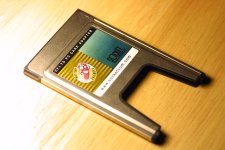
After making some test shots on the Microdrive, I attempted to download the pictures onto my Sony Vaio notebook. To download pictures to my notebook, I generally avoid the more cumbersome USB card readers and, instead, use my trusty "CFI TO PC CARD ADAPTER". CFI stands for CompactFlash Type I. PC Card is the same as PCMCIA. This type of adapter is slim, no wires, and easy to carry around. This adapter allows CompactFlash cards to be plugged into the PCMCIA Type II port on a notebook. However, attempting to plug the Microdrive into this adapter proved futile, since the Microdrive uses CompactFlash Type II (CFII) form factor.
Although the electrical interfaces of CFI and CFII are identical, the cards have different thickness. CF Type I is 3.3 mm thick and CF Type II cards are 5mm thick. In the picture below, you can see the thickness between PCMCIA Type II card (left), CFII card (middle), and CFI card (right).

As you can see, the thickness of the PCMCIA Type II card and CFII card are exactly the same.
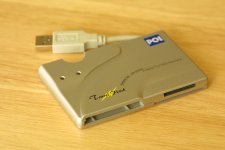
The first thing I did was drive down to the nearest Fry's Electronic and purchased a "PQI FLASHCARD Compact Flash Adapter". The packaging claimed that it could accept Microdrive. When I got home, I realized that the packaging had lied, as I can not get the Microdrive to plug into the adapter. Quite up-set at this point, I drove down to Fry's Electronics again and purchased the "PQI TravelFlash 5 in 1 USB Card Reader/Writer". The packaging on this even shows an IBM 340 MB Microdrive. Well . . . I was quite disappointed that after getting the USB reader/writer to work, it could not recognize my IBM 1 GB Microdrive. Perhaps the power consumption of the 1 GB version is much higher than the 340 MB version. My other CompactFlash solid-state memory cards did work with this USB reader/writer.
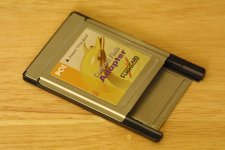
After giving up with the USB reader/writer, I decided to try hacking the "PQI FLASHCARD Compact Flash Adapter" to see if I can get it to accept the CFII Microdrive. I really much prefer the PCMCIA adapter to the USB reader/writer, anyway.
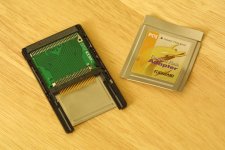
The adapter is a piece of black plastic sandwiched by two metal covers, with the circuit board in the middle of the adapter. I carefully pulled off the top metal piece. It was held to the plastic by some sort of double-sided tape.
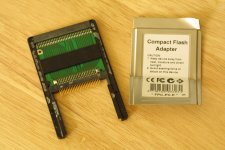
Next, I turned the adapter over and carefully pulled off the bottom metal piece, without breaking the plastic pieces. The plastic piece and the circuit board are vital parts of this adapter. Obviously, the circuit board is used to interface the CFI and CFII cards to the PCMCIA port. The black plastic is used as guide for the easy insertion and removal of the adapter card.
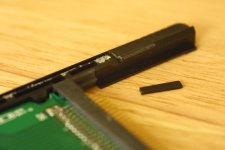
After pulling off both metal covers, the Microdrive still can not be inserted into the adapter. There are two tabs blocking the Microdrive from being inserted. I was able to break the two tabs off with my thumb. But it will probably be even easier with pliers or other tools.
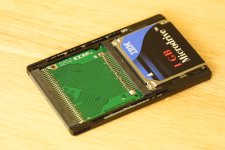
With the tabs out of the way, the Microdrive can be inserted into the adapter. As mentioned before the electrical interface of CFI and CFII are identical; see the CompactFlash Frequently Asked Questions (FAQ) for more detail. However, using the Microdrive and your notebook with this kind of hack may void the warranty on your equipment. I will not be responsible for your equipment. You have been warned.
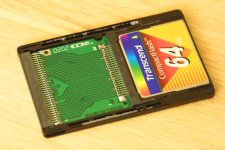
This hacked adapter can still be used with a regular CompactFlash Type I card; allowing me to carry only one adapter, instead of two.
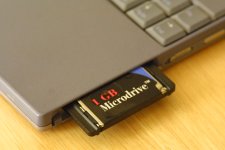
I have used this hack successfully with my Sony Vaio notebook and IBM 1 GB Microdrive. Of course, like I said before, this use can void the warranty of your equipment.
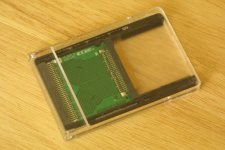
Without the metal casing, the hacked adapter is rather fragile. The circuit board is also not glued to the black plastic guide. So now, I always carry this adapter in a clear plastic PC Card case. It keeps the circuit board from harm and the pins from being bent. I can even carry one Microdrive or one solid-state memory card with the adapter.
If you are not interested in performing this hack yourself, but would still like a PCMCIA adapter for your Microdrive, or other CFII cards, you can obtain one directly from IBM or Iomega; see Related Links below. I went with the hack because I did not want to deal with the price, shipping, and the hassle of getting one ordered.
Related Links
- CompactFlash Association
- CompactFlash Frequently Asked Questions
- Controlling a CompactFlash+ Slot
- IBM Microdrive
- IBM MD340 340MB Microdrive with CompactFlash Adapter Review at Amazon
- IBM MD340/A 340MB Microdrive with Travel Kit Review at Amazon
- Iomega Microdrive
- Iomega 31650 Microdrive 340 MB Review at Amazon
- Make a PCMCIA Slot Memory Card Carrier
- PCMCIA - Personal Computer Memory Card International Association
- Solution from PC Magazine: Do-It-Yourself: To Do...
- Using CF/PCMCIA cards on the IDE interface
- Viking CF-ADAPT Adapter for using Compact Flash in a PC Card slot Review at Amazon
160 Users Online
|
$10000-above $5000-$9999 $2000-$4999 $1000-$1999 $500-$999 $200-$499 $100-$199 $50-$99 $25-$49 $0-$24 Gift Certificate |
|


